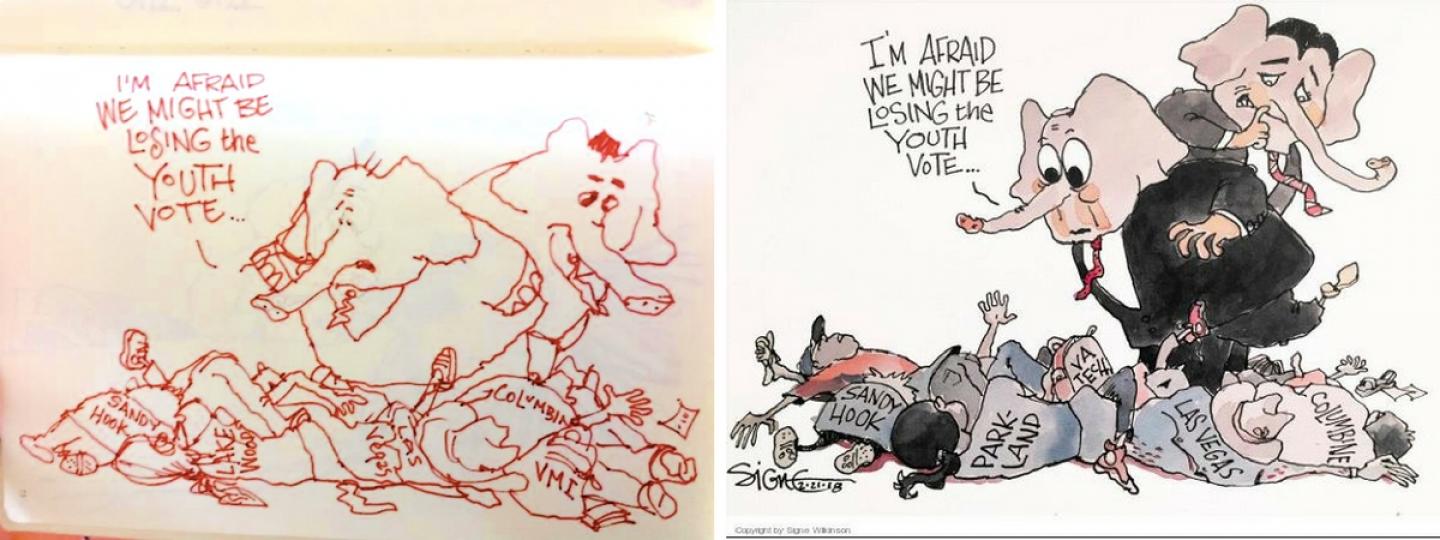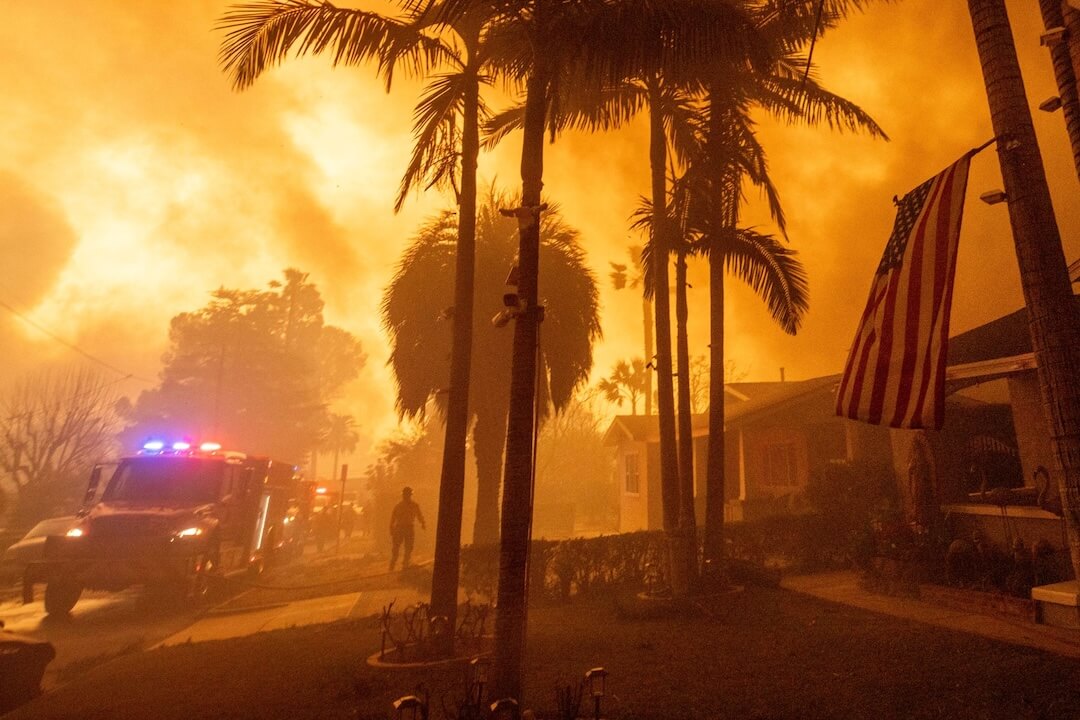America’s editorial cartoonists have been struggling to portray the outage of mass school shootings for more than two decades. How do they make each one different? Will this latest shooting in Parkland — and the #NeverAgain movement — lead to change?
For the Philadelphia Inquirer’s Signe Wilkinson, the Parkland massacre came as she was on a trip, with limited internet, in Guatemala. “Bouncing in a van over a mountain to Antigua, I was stewing over the tragedy. Images occurred and rough-sketched two toons,” she emails from Guatemala City. (One of them — and the finished version — is above this article.)
Below are Q&As on Parkland, #NeverAgain and the Trump era with three other cartoonists: Ann Telnaes of the Washington Post, Rob Rogers of the Pittsburgh Post-Gazette and Sage Stossel from The Atlantic. Telnaes and Rogers messaged via email; Sage spoke on the phone.
You've sought to illustrate several past school shootings. What makes Parkland different?
Telnaes: Yes, I’ve done so many gun cartoons in my 25-year career I can’t remember them all. And while the gut-wrenching illustrations which deal with the tragedy of lives lost can be powerful, an editorial cartoonist’s job is to criticize the actions and policies of the politicians and institutions who are protecting their own interests.
Buying in bulk, from @AnnTelnaes (from November) #LasVegas #Parkland pic.twitter.com/zzNzFmCLvk
— David Beard (@dabeard) February 22, 2018
I’ve also addressed the apathy of Americans about shootings in past cartoons, but the Parkland mass shootings are different because of the fierce outspokenness of the high school students.
Rogers: The first shooting that I remember drawing multiple cartoons about was Columbine. In that case there was an attempt to blame everything from violent video games to the “Matrix” movie and trench coats.
What makes Parkland different, at least at this point, is the fact that the surviving students have become very actively involved in the discussion about gun control. And they aren't just going on camera to grieve and ask why, they are demonstrating and speaking out in an articulate way about how gun laws and politicians have failed them.
Puppets, by @Rob_Rogers #Parkland #WayneLaPierre pic.twitter.com/v2G8PDyDQz
— David Beard (@dabeard) February 22, 2018
If any real change happens this time, it will be because of those kids.
I believe the best political cartoons come from a place of outrage and anger. This issue definitely fills me with both. Sure, I wonder to myself, as I am sure most journalists covering this issue do, how in the world will I ever be able to come up with something new and fresh on this issue that will adequately express the anger and outrage? There is a numbness that sets in. I am sure cartoonists thought the same thing during the civil rights era or the Vietnam War. How many times can I draw about this? When will the madness or injustice end?
At least as a cartoonist I have an outlet for my frustration and anger. But it is difficult to draw about tragedy, especially for someone who usually deals in satirical humor. There is nothing funny about school shootings.
Stossel: My first topical cartoon came in 1996 for The Atlantic website. School shootings have come up ever since. It’s happened over and over again. It’s hard to find a new angle, even though each incident is so horrifying that it deserves a new angle.
This does feel different. After Newtown, it felt like Game Over. If that wouldn’t change things, then nothing would.
People underestimated these (Parkland) survivors … they’re articulate, confident in the use of new tools. They’re inherently cooler.
Do you think, as a cartoonist, that this event will keep reverberating — and what topics does that lead you into?
Stossel: As a cartoonist, I never have confidence that I will have another idea, from a creative standpoint … but I really hope this movement continues. They’ve just started out, and they’re not jaded, they have plenty of energy. They will have to find their way around obstacles, but they seem motivated and smart enough to succeed.
Rogers: I do think school shootings will keep reverberating because the issue reveals real people with real stories. No matter how numb we get to the headlines of shootings in America, it will never be okay as long as children and loved ones are dying for no reason.
As for the topics it brings up, there are many. The biggest one for me is money in politics. The government is controlled (held hostage) by special interests. If we had serious campaign finance reform, politicians would not be beholden to or so frightened of the NRA. Gun lobbies would not be allowed to have the kind of influence they have now. This would allow Washington to pass sensible gun laws, like going back to a ban on assault weapons, background checks, etc.
Cartoonists have been through this drill many times before. Here's @Rob_Rogers of the @PittsburghPG, after the #LasVegas massacre. #Parkland pic.twitter.com/MR3pFimOfj
— David Beard (@dabeard) February 22, 2018
Over the past year or so, commentators tell us that political norms have been shattered. Have norms for cartoonists been shattered, too? Are you covering things a different, blunter way than you used to?
Telnaes: Yes, I think editorial cartoonists are operating in a different political climate now than the profession has been in for many years — but in an environment where we come up with our best work. Historically the role of an editorial cartoonist is to target through satire and ridicule the abuses of power by our leaders and institutions and holding them accountable to the people they are supposed to serve — “puncturing pomposity,” as Herblock once said.
While this isn’t the first time we’ve seen corruption in higher office or political parties pushing policies to benefit their interests, this is the first time we’ve had a president who doesn’t understand or willfully disregards things like separation of powers or the role of a free press in a democracy, and is doing it openly. This is what editorial cartoonists are born to expose and point their pens at.
Rogers: When people find out I am an editorial cartoonist they say, "Wow, you must be loving Trump!" or "You've got it made" with him in the White House. Yes and no. They don't realize that it isn't as easy as it looks. An important tool for any satirist is exaggeration. Trump is already so exaggerated it is difficult to stretch that to get the element of surprise.
Stossel: It depends on the cartoonist. There are always cartoonists who are pushing through to the outer limits … I came into this field with a whimsical view, trying to be clever. With the rise of Trump, I have felt the need to push back harder, using the medium with the tools at your disposal. … It feels like so much is in play.
America to its teens, by @sagestossel for @TheAtlantic #Parkland #NeverAgain #WayneLaPierre pic.twitter.com/oVEwylWutV
— David Beard (@dabeard) February 22, 2018






